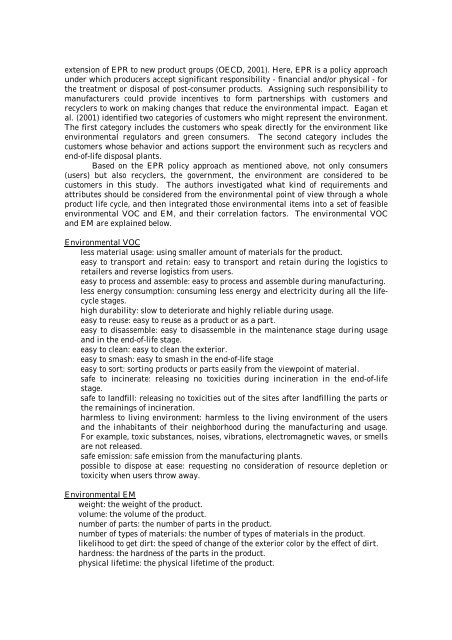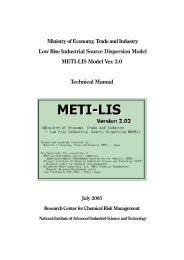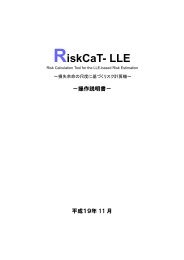Quality Function Deployment for Environment
Quality Function Deployment for Environment
Quality Function Deployment for Environment
Create successful ePaper yourself
Turn your PDF publications into a flip-book with our unique Google optimized e-Paper software.
extension of EPR to new product groups (OECD, 2001). Here, EPR is a policy approachunder which producers accept significant responsibility - financial and/or physical - <strong>for</strong>the treatment or disposal of post-consumer products. Assigning such responsibility tomanufacturers could provide incentives to <strong>for</strong>m partnerships with customers andrecyclers to work on making changes that reduce the environmental impact. Eagan etal. (2001) identified two categories of customers who might represent the environment.The first category includes the customers who speak directly <strong>for</strong> the environment likeenvironmental regulators and green consumers. The second category includes thecustomers whose behavior and actions support the environment such as recyclers andend-of-life disposal plants.Based on the EPR policy approach as mentioned above, not only consumers(users) but also recyclers, the government, the environment are considered to becustomers in this study. The authors investigated what kind of requirements andattributes should be considered from the environmental point of view through a wholeproduct life cycle, and then integrated those environmental items into a set of feasibleenvironmental VOC and EM, and their correlation factors. The environmental VOCand EM are explained below.<strong>Environment</strong>al VOCless material usage: using smaller amount of materials <strong>for</strong> the product.easy to transport and retain: easy to transport and retain during the logistics toretailers and reverse logistics from users.easy to process and assemble: easy to process and assemble during manufacturing.less energy consumption: consuming less energy and electricity during all the lifecyclestages.high durability: slow to deteriorate and highly reliable during usage.easy to reuse: easy to reuse as a product or as a part.easy to disassemble: easy to disassemble in the maintenance stage during usageand in the end-of-life stage.easy to clean: easy to clean the exterior.easy to smash: easy to smash in the end-of-life stageeasy to sort: sorting products or parts easily from the viewpoint of material.safe to incinerate: releasing no toxicities during incineration in the end-of-lifestage.safe to landfill: releasing no toxicities out of the sites after landfilling the parts orthe remainings of incineration.harmless to living environment: harmless to the living environment of the usersand the inhabitants of their neighborhood during the manufacturing and usage.For example, toxic substances, noises, vibrations, electromagnetic waves, or smellsare not released.safe emission: safe emission from the manufacturing plants.possible to dispose at ease: requesting no consideration of resource depletion ortoxicity when users throw away.<strong>Environment</strong>al EMweight: the weight of the product. volume: the volume of the product.number of parts: the number of parts in the product.number of types of materials: the number of types of materials in the product. likelihood to get dirt: the speed of change of the exterior color by the effect of dirt.hardness: the hardness of the parts in the product.physical lifetime: the physical lifetime of the product.




